英语语言学第五章semantics
- 格式:ppt
- 大小:604.50 KB
- 文档页数:40
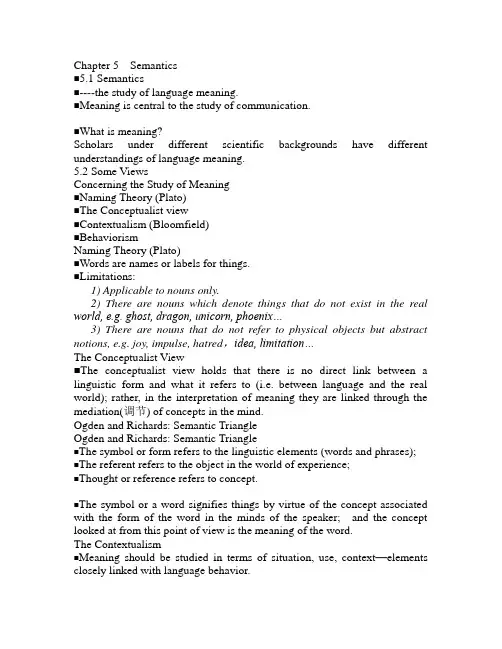
Chapter 5 Semantics⏹5.1 Semantics⏹----the study of language meaning.⏹Meaning is central to the study of communication.⏹What is meaning?Scholars under different scientific backgrounds have different understandings of language meaning.5.2 Some ViewsConcerning the Study of Meaning⏹Naming Theory (Plato)⏹The Conceptualist view⏹Contextualism (Bloomfield)⏹BehaviorismNaming Theory (Plato)⏹Words are names or labels for things.⏹Limitations:1) Applicable to nouns only.2) There are nouns which denote things that do not exist in the real world, e.g. ghost, dragon, unicorn, phoenix…3) There are nouns that do not refer to physical objects but abstract notions, e.g. joy, impulse, hatred,idea, limitation…The Conceptualist View⏹The conceptualist view holds that there is no direct link between a linguistic form and what it refers to (i.e. between language and the real world); rather, in the interpretation of meaning they are linked through the mediation(调节) of concepts in the mind.Ogden and Richards: Semantic TriangleOgden and Richards: Semantic Triangle⏹The symbol or form refers to the linguistic elements (words and phrases);⏹The referent refers to the object in the world of experience;⏹Thought or reference refers to concept.⏹The symbol or a word signifies things by virtue of the concept associated with the form of the word in the minds of the speaker; and the concept looked at from this point of view is the meaning of the word.The Contextualism⏹Meaning should be studied in terms of situation, use, context—elements closely linked with language behavior.⏹Two types of contexts are recognized:⏹Situational context: spatiotemporal situation⏹Linguistic context: the probability of a word‟s co-occurrence or collocation.⏹For example, “black” in black hair & black coffee, or black sheep differs in meaning; “The president of the United States” can mean either the president or presidency in different situation.⏹他把自行车修好了。
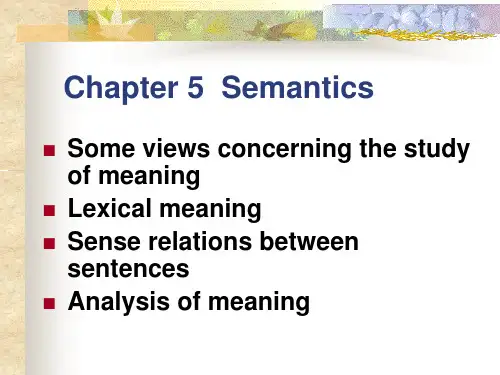
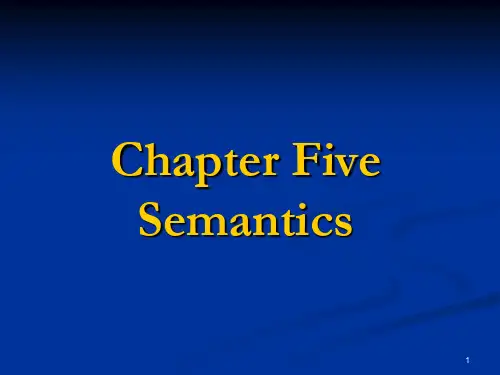
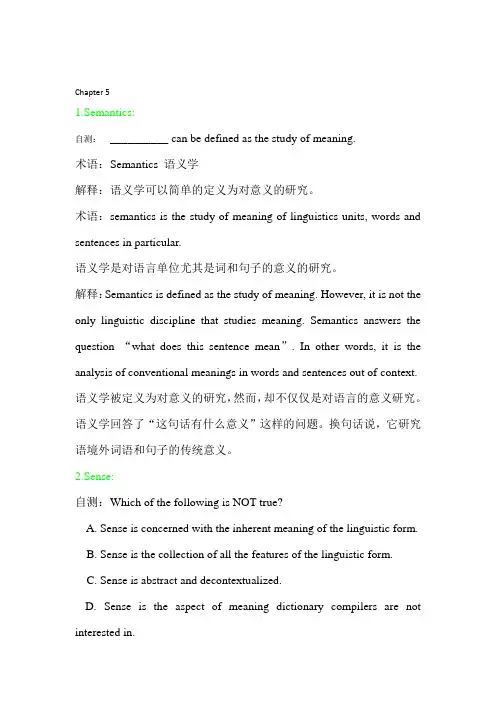
Chapter 51.Semantics:自测: __________ can be defined as the study of meaning.术语:Semantics 语义学解释:语义学可以简单的定义为对意义的研究。
术语:semantics is the study of meaning of linguistics units, words and sentences in particular.语义学是对语言单位尤其是词和句子的意义的研究。
解释:Semantics is defined as the study of meaning. However, it is not the only linguistic discipline that studies meaning. Semantics answers the question “what does this sentence mean”. In other words, it is the analysis of conventional meanings in words and sentences out of context. 语义学被定义为对意义的研究,然而,却不仅仅是对语言的意义研究。
语义学回答了“这句话有什么意义”这样的问题。
换句话说,它研究语境外词语和句子的传统意义。
2.Sense:自测:Which of the following is NOT true?A. Sense is concerned with the inherent meaning of the linguistic form.B. Sense is the collection of all the features of the linguistic form.C. Sense is abstract and decontextualized.D. Sense is the aspect of meaning dictionary compilers are not interested in.术语:Sense 涵义解释:涵义指一个实体的抽象属性。


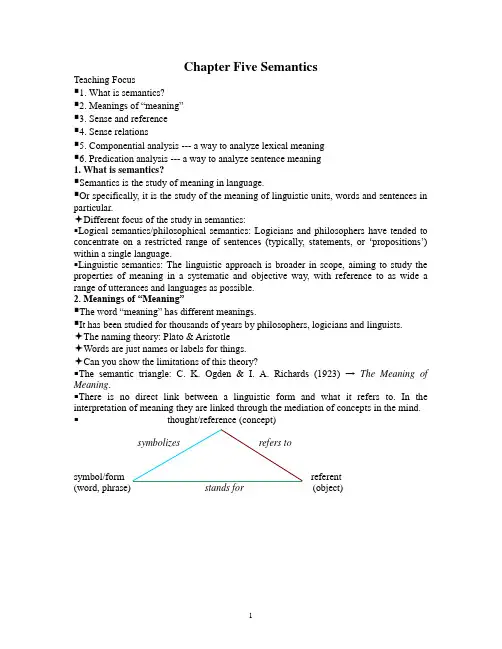
Chapter Five SemanticsTeaching Focus▪1. What is semantics?▪2. Meanings of “meaning”▪3. Sense and reference▪4. Sense relations▪5. Componential analysis --- a way to analyze lexical meaning▪6. Predication analysis --- a way to analyze sentence meaning1. What is semantics?▪Semantics is the study of meaning in language.▪Or specifically, it is the study of the meaning of linguistic units, words and sentences in particular.✦Different focus of the study in semantics:▪Logical semantics/philosophical semantics: Logicians and philosophers have tended to concentrate on a restricted range of sentences (typically, statements, or …propositions‟) within a single language.▪Linguistic semantics: The linguistic approach is broader in scope, aiming to study the properties of meaning in a systematic and objective way, with reference to as wide a range of utterances and languages as possible.2. Meanings of “Meaning”▪The word “meaning” has different meanings.▪It has been studied for thousands of years by philosophers, logicians and linguists.✦The naming theory: Plato & Aristotle✦Words are just names or labels for things.✦Can you show the limitations of this theory?▪The semantic triangle: C. K. Ogden & I. A. Richards (1923) → The Meaning of Meaning.▪There is no direct link between a linguistic form and what it refers to. In the interpretation of meaning they are linked through the mediation of concepts in the mind. ▪thought/reference (concept)symbolizes refers tosymbol/form referent(word, phrase) stands for(object)▪Geoffrey Leech (1974, 1981). Semantics: The Study of Meaning. Seven types of meaning:✦Conceptual meaning✦Connotative meaning✦Social meaning✦Affective meaning associative meaning✦Reflected and meaning✦Collocative meaning✦Thematic meaning(1) Conceptual meaning▪It makes the central part of meaning.✦Refers to logical, cognitive or denotative content.✦Concerned with the relationship between a word and the thing it denotes, or refers to.(2) Connotative meaning▪The communicative value an expression has by virtue of what it refers to, over and above its purely conceptual content.✦A multitude of additional, non-criterial properties, including not only physical characteristics but also psychological and social properties, as well as typical features. ▪Involving the …real world‟ experience one associates with an expression when one uses or hears it.✦Unstable: they vary considerably according to culture, historical period, and the experience of the individual.▪Any characteristic of the referent, identified subjectively or objectively, may contribute to the connotative meaning of the expression which denotes it.(3) Social meaning▪What a piece of language conveys about the social circumstances of its use.✦Dialect: the language of a geographical region or of a social class.✦Time: the language of the 18th c., etc.✦Province: language of law, of science, of advertising, etc.✦Status: polite, colloquial, slang, etc.✦Modality: language of memoranda, lectures, jokes, etc.✦Singularity: the style of Dickens, etc.▪domicile: very formal, official steed: poetic▪residence: formal horse: general▪abode: poetic nag: slang▪home: general gee-gee: baby language (4) Affective meaning▪Reflecting the personal feelings of the speaker, including his attitude to the listener, or his attitude to something he is talking about.✦You‟re a vicious tyrant and a villainous reprobate, and I hate you for it!✦I‟m terribly sorry to interrupt, but I wonder if you would be so kind as to lower your voices a little. or✦Will you belt up.(5) Reflected meaning▪Arises in cases of multiple conceptual meaning, when one sense of a word forms part of our response to another sense.✦When you hear …click the mouse twice‟, you think of Gerry being hit twice by Tom so you feel excited.▪Many taboo terms are result of this.(6) Collocative meaning▪The associations a word acquires on account of the meanings of words which tend to occur in its environment.✦pretty: girl, boy, woman, flower, garden, colour, village, etc.✦handsome: boy, man, car, vessel, overcoat, airliner, typewriter, etc.(7) Thematic meaning▪What is communicated by the way in which a speaker or writer organizes the message, in terms of ordering, focus, and emphasis.✦Mrs Bessie Smith donated the first prize.✦The first prize was donated by Mrs Bessie Smith.✦They stopped at the end of the corridor.✦At the end of the corridor, they stopped.3. Sense and reference▪Sense and reference are two terms often encountered in the study of word meaning. They are two related but different aspects of meaning.✦Sense is concerned with the inherent meaning of the linguistic form. It is the collection of all the features of the linguistic form; it is abstract and de-contextualized. It is the aspect of meaning dictionary compilers are interested in.✦Reference means what a linguistic form refers to in the real, physical world; it deals with the relationship between the linguistic element and the non-linguistic world of experience.▪Every word has a sense, but not every word has a reference.✦Grammatical words like but, if ,and do not refer to anything. And words like God, ghost and dragon refer to imaginary things.▪Therefore it is suggested that we should study meaning in terms of sense rather than reference.4. Sense relations▪Synonymygradable▪Antonymy complementaryconverse▪Hyponymy▪Polysemy4.1 Synonymy▪Synonymy refers to the sameness or close similarity of meaning. Words that are close in meaning are called synonyms.▪Complete synonyms are rare. According to the way they differ, synonyms can be divided into the following groups:▪i. Dialectal synonyms --- used in different regional dialects✦British English American English✦autumn fall✦lift elevator✦flat apartment✦tube underground▪ii. Stylistic synonyms --- differing in style✦kid, child, offspring✦kick the bucket, pop off, die, pass away, decease▪iii. Synonyms that differ in their emotive or evaluative meaning✦collaborator, accomplice▪iv. Collocational synonyms✦accuse, charge▪v. Semantically different synonyms✦surprise, amaze, astound4.2 Antonymy▪The term antonymy is used for oppositeness of meaning. Words that are opposite in meaning are antonyms.▪There are three types of antonyms.▪i. Gradable: Can be modified by adverbs of degree like very; Can have comparative forms; Can be asked with how.✦good, bad✦young, old✦hot, cold▪ii. Complementary: the denial of one member of the pair implies the assertion of the other.✦alive, dead✦male, female✦present, absent▪iii. Converse or relational: exhibit the reversal of a relationship between the pair; one presupposes the other.✦husband, wife✦buy, sell✦before, after4.3 Hyponymy▪Hyponymy refers to the sense relation between a more general word and a more specific word. It is a kind of inclusiveness.▪Superordinate: the more general word▪Hyponyms: the more specific words▪Co-hyponyms: hyponyms of the same superordinate✦flower, rose, lily✦animal, cat, dog✦furniture, bed, desk4.4 Polysemy▪Polysemy refers to the sense relation that the same one word has more than one meaning. Such a word is called a polysemic word.✦table: a piece of furniture; orderly arrangement of facts, figures5. Componential analysis---a way to analyze lexical meaning▪Componential analysis is a way proposed by the structural semanticists to analyze word meaning.▪The approach is based upon the belief that the meaning of a word can be dissected into meaning components, called semantic features.▪HUMAN✦man (ADULT, MALE)✦woman (ADULT, FEMALE)✦boy (NON-ADULT, MALE)✦girl (NON-ADULT, FEMALE)▪father: PARENT (x, y) & MALE (x)✦x is a parent of y, and x is male.▪take: CAUSE (x, (HA VE (x, y)))✦x causes x to have y.▪give: CAUSE (x, (~HA VE (x, y)))✦x causes x not to have y.▪Componential analysis provides an insight into the meaning of words and a way to study the relationships between words that are related in meaning.6. Predication analysis --- a way to analyze sentence meaning▪The meaning of a sentence is obviously related to the meanings of the words used in it, but it is also obvious that sentence meaning is not simply the sum total of the words.▪Predication analysis: proposed by the British linguist G. Leech▪The basic unit in this method is called prediction. It is the abstraction of the meaning of a sentence.▪A predication consists of argument(s) and predicate.✦An argument is logical participant in a predication, largely identical with the nominal element(s) in a sentence.✦A predicate is something said about an argument or it states the logical relation linking the arguments in a sentence.▪Tom smokes.▪Tom is smoking.▪Tom has been smoking. TOM (SMOKE)▪Does Tom smoking?▪Tom does not smoke. argument predicate▪Kids like apples. → KID, APPLE (LIKE)▪It is hot. → (BE HOT)Assignments▪How can words opposite in meaning be classified? To which category does each of the following pairs of antonyms belong?▪north/south vacant/occupied▪literate/illiterate above/below▪doctor/patient wide/narrow▪poor/rich father/daughter▪honest/dishonest normal/abnormalExercises▪I. Multiple choice.▪1. The naming theory seems applicable to ___ only.▪A. verbs B. adjectives C. adverbs D. nouns▪2. Hyponyms of the superordinate “flower” do not include “___”.▪A. wardrobe B. tulip C. lily D. rose▪3. Predication analysis is a way to analyze ___ meaning.▪A. phoneme B. word C. phrase D. sentence▪II. Make judgments (true or false)▪1. In the diagram of the classic semantic triangle, the word “symbol” refers to the object in the world of experience.▪2. When the same one word has more than one meaning we call it a polysemic word. ▪3. Complete synonyms, i.e. synonyms that are mutually substitutable under all circumstances, are rare in English.。
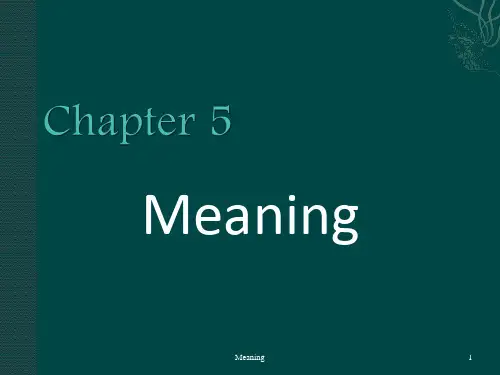
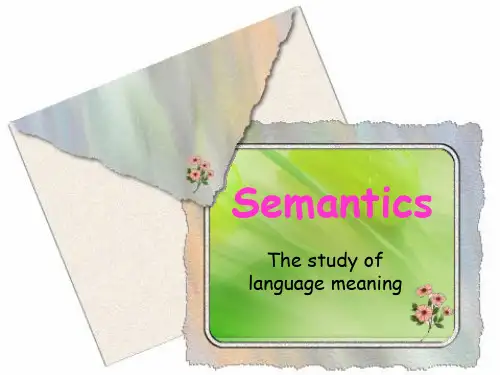
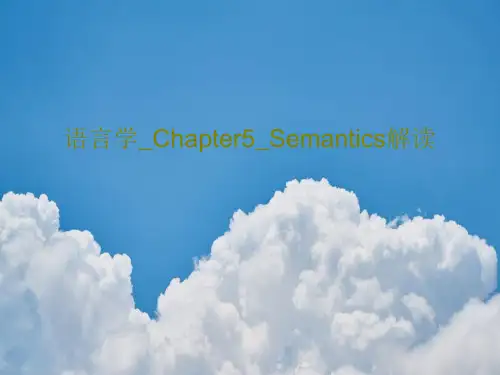
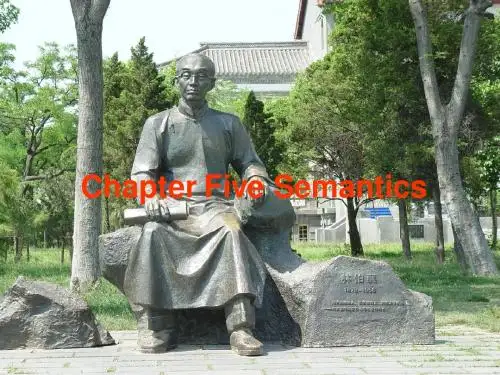
semantics含义和举例
Semantics是一个英语词汇,指的是语言学和逻辑学中与词义、句义以及语言表达的意义相关的概念和研究领域。
在语言学中,semantics研究词汇和句子的意义,并探讨词汇和句子之间的
关系。
在逻辑学中,semantics研究命题、谓词和推理等的意
义和语义逻辑。
举例:
1. 在语言学中,semantics可以用来解释词汇的意义。
比如,
英语单词"dog"的semantics是指代一种四肢的、长尾巴的、被
驯化且以人类为主要伙伴的哺乳动物。
2. 在逻辑学中,semantics可以用来解释谓词和推理的意义。
例如,谓词"是母亲"的semantics可以定义为"对于一个人x,
如果存在一个人y,y是x的孩子,则x是母亲"。
3. 在计算机科学中,semantics可以用来解释编程语言的意义。
比如,当编写一个计算两个数之和的程序时,semantics可以
定义为将两个数相加并返回结果的操作。
总而言之,semantics的含义涵盖了语言学、逻辑学和计算机
科学等多个学科领域。
它帮助我们理解和研究词汇、句子、命题以及计算机程序等的意义和语义关系。
Chapter 5 Semantic5.1 DefinitionThe study of meaning in language; how meaning is represented in languages.About the linguistics units, words and sentencesImportant meaning: the basic function of language in communication.5.2 Approaches to meaning5.2.1Word meaningThe naming theory: definition, important figures, some problems in naming theory.The conceptualist view: definition, a problem with conceptualist view.Linguistics model of conceptualist viewThough(concept)Symbol(form) ReferentThe behaviorism: definition, important figures, problems with behaviorismContextualism: definition, important figures, a problem with contextualismConventionality and motivation5.3 word meaningReference: how languages refer to this external worldSense: the way people relate words to each other within the framework of their language.Types of meaning1) conceptual meaning2)connotative meaning3)social meaning associative meaning4)affective meaning5)reflectied meaning6)collocative meaning7)thematic meaningPolysemy and HomonymyPolysemy: to be the result from the change of meaning. Homonymy: refers to the case where lexemes with the same phonological or morphological shape have the different meaning.Homonymyhomophones homographs complete homonyms site,sight tear n, tear v lead n. lead vSynonymy1)sources of synonymy:borrowing, dialects and regional EnglishFigurative and euphemistic of wordsCoincidence with idiomatic expressionAntonymy1)complementary antonyms2)Gradable antonyms3)Relational antonymsTypes1)semantic antonyms2)Stylistic purpose of the use of antonymsSentence meaning1)sentence and propositionSentence: definition: a unit of language, a string of words put together by the grammatical rules of a language.Proposition:the basic idea/thought of the sentence;events or states; say something about events/states.Proposition: predicate+argument(s)Semantic Roles: Agent, patient, instrument, goal, beneficiary.Intersentential semantic relationsA entailment (蕴含)B presupposition(前提)C inconsistency (矛盾)D synonymy (同义)Exercise2(1) (a) and (b) words are “nature”(a) words are plants(b) words are animals(2) (a)and(b) words are “food”(a) words are snakes(b)words are liquids(3) (a)and(b) words are “adjective ”(a)words are derogatory term(b)words are commendatory term(4) (a)and(b) words are “food”(a)words are nuts(b)words are fruits(5) (a)and(b) words are “stationery”(a)words are book(b)words are writing tools(6)(a) and(b) words are “ sport”(a)words are easy(b)Words are difficult(7)(a) and(b) words are “verb”(a) words are normal(b) words are specific(8)(a)and (b) words are “life”(a) words are the process of the life(b) words are the expression of the people(9)(a) and(b) words are “food”(a) words are meat(b) words are vegetables(10)(a) and (b) words are “adjective”(a)words are common(b) words about dangerousMini research。